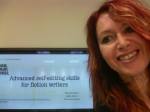 Here’s another of my favourite discussions from my recent Guardian self-editing masterclass…
Here’s another of my favourite discussions from my recent Guardian self-editing masterclass…

How to write several narrators and make them sound distinct
One student had several narrators and was finding it hard to make them distinct. His writer group reported that they sounded too similar, especially in dialogue. One character was male and one female, so some of his critiquers were assuming the gender was the problem; that he as a male couldn’t write as a female.
Hold it there. Some writers – and readers – believe that males can’t write plausible females and vice versa. And certainly, there may be some gender-specific mentalities that are impossible to disguise … but before we all assume we’re tethered to our chromosomes, let’s consider what makes a character distinct.
Difference usually comes from outlook, education standard, moral compass, background and the character’s emotional state. I thought it far more likely that the problem came from not making the characters individual enough, rather than the influence of our writer’s gender.
Sure enough, he said that when he explored his writing group’s objection, they had observed that his characters used similar vocabulary in dialogue. So perhaps the problem was not gender at all.
Where the differences really lie
If you have several narrators, you need to find different ways for them to express themselves. Different catch-phrases, senses of humour, frames of reference, moral and social codes.
 If you like writing with music, that can take you to a gut sense of who your different people are – this post on The Undercover Soundtrack by actor-writer Jason Hewitt shows how a few talisman pieces of music conjured a character’s state of mind and helped him remember who each person was … on the inside.
If you like writing with music, that can take you to a gut sense of who your different people are – this post on The Undercover Soundtrack by actor-writer Jason Hewitt shows how a few talisman pieces of music conjured a character’s state of mind and helped him remember who each person was … on the inside.
Two characters …. two tenses?
Another of my students had a similar problem. She had two characters in the Arctic; one a hard-bitten scientist, the other a wonder-struck friend who was visiting. They narrated alternate chapters. In her own mind she had a sense of how they were distinct, but despite this she found they sounded too similar on the page. So she decided she’d write one as first-person present and the other as close-third past.
I said I thought that sounded confusing. Some readers would think the shift of tenses was significant in story terms and would look for a reason. Did it mean the action was happening at a different time? Was it a parallel thread? I suggested she scrap that approach and look more forensically at the characters’ outlook, attitudes etc. She agreed as she’d worried about that herself.
But then she said something that was rather interesting.
She’d never written in first-person present before, and when she did she found she felt and thought differently. She found herself inventing all sorts of back story and behaviour that took her by surprise. By squiffing the tenses, she’d hit on a new creative mindset that suited this book.
The verdict was clear – and exciting; write a discovery draft in these two tenses. Then edit and make them uniform, marvelling at the new inventions. Eureka.
Just like listening to music, a change of writing style or technique can get you to new places. Do whatever you need to, then tidy up afterwards. The reader never needs to know how you did it.
 There are a lot more discussions on how to make characters distinct in Writing Characters Who’ll Keep Readers Captivated: Nail Your Novel 2.
There are a lot more discussions on how to make characters distinct in Writing Characters Who’ll Keep Readers Captivated: Nail Your Novel 2.
Have you tackled a similar problem? Especially, have you hit on any tricks that helped you give your characters different voices, and then later removed the evidence of how you did it?

I need exactly this advice for the project I’m currently working on 🙂
*Adopts a sage expression.*
Hi Roz. English Passengers by Matthew Kneale is my main reference point for how to write multiple narrators. Follows your model of giving the different characters different reference points, class and nationality being major ones. After all, if your characters are approaching the story from the same angle, what’s the point?
Cheers,
Jonathan
Hi Jonathan! Wise example, as always. I particularly like your point about characters approaching from the same viewpoint. In real life, you might have a number of people who all feel and think similarly. But in a story we want more contrast and variety.
Reblogged this on Notes from An Alien and commented:
Roz Morris nails the issue of more than one Narrator Voice in today’s re-blog 🙂
Hope I managed this in my last book as all the others were written in third person and I really thought I couldn’t do first person. Then I found the story needed different points of view, male and female.I let the story dictate the method and was ready to change if necessary. I love visualising my characters as if I was watching a film. Great advice.
‘I let the story dictate the method….’ which is just as it should be. thanks for stopping by, Julie!